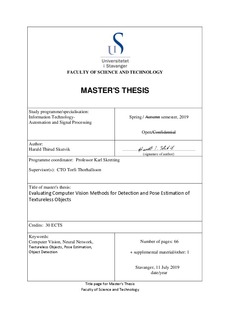| dc.contributor.advisor | Skretting, Karl | |
| dc.contributor.advisor | Thorhallsson, Torfi | |
| dc.contributor.author | Skutvik, Harald Thirud | |
| dc.date.accessioned | 2019-10-04T08:45:41Z | |
| dc.date.available | 2019-10-04T08:45:41Z | |
| dc.date.issued | 2019-06 | |
| dc.identifier.uri | http://hdl.handle.net/11250/2620242 | |
| dc.description | Master's thesis in Automation and signal processing | nb_NO |
| dc.description.abstract | Robotics, AI and automation; search for these words and two things become apparent. An era of automation is upon us, but even so there are still some simple tasks that grinds it to a halt, e.g. picking and placing objects. These simple tasks require coordination from a robot, and object detection from a computer vision system. That’s not to say that robots are incapable of picking up objects, as the simple and organised cases have been solved some time ago. The problems occur in cases where there are no order, in other words chaos. In these cases it is beneficial to detect and find the pose of the object, so that it can be picked up and packed while having full control over the position the object was placed in. This thesis is written at the behest of Pickr.ai, a company looking to automate the picking and packing for retail businesses.
The objective of this thesis is to evaluate available pose estimating methods, and if possible single out one that is best suited for the retail environment. Current state of the art methods that are capable of estimating the pose of objects utilise convolutional neural networks for both detection and estimation. The leading methods can achieve accuracy upwards of the high 90% on pretrained objects. The case with retail is that the volume of available wares may be so large that training on each item is prohibitive. Therefore the testing done has mostly been aimed at the method’s generalisability, whether they can detect objects without prior training specific for the object.
A few different methods with varying solutions were examined, from the simpler pure object detectors to two stage 6D pose estimators. Unfortunately none of the methods can be deemed appropriate for the task as it currently stands. The methods do not recognise new objects, and the improvement from limited training does not improve the scores significantly. However, by applying the approaches that are incorporated in the other methods, it may be possible to develop an appropriate new pose estimator capable of handling a retail environment. | nb_NO |
| dc.language.iso | eng | nb_NO |
| dc.publisher | University of Stavanger, Norway | nb_NO |
| dc.relation.ispartofseries | Masteroppgave/UIS-TN-IDE/2019; | |
| dc.rights | Navngivelse 4.0 Internasjonal | * |
| dc.rights.uri | http://creativecommons.org/licenses/by/4.0/deed.no | * |
| dc.subject | informasjonsteknologi | nb_NO |
| dc.subject | signalbehandling | nb_NO |
| dc.subject | automatisering | nb_NO |
| dc.title | Evaluating Computer Vision Methods for Detection and Pose Estimation of Textureless Objects | nb_NO |
| dc.type | Master thesis | nb_NO |
| dc.subject.nsi | VDP::Technology: 500::Information and communication technology: 550 | nb_NO |

